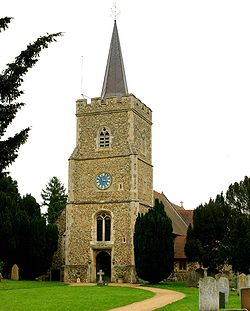Hertingfordbury
| Hertingfordbury | |
| Hertfordshire | |
|---|---|
 Hertingfordbury | |
| Location | |
| Grid reference: | TL307119 |
| Location: | 51°47’27"N, 0°6’19"W |
| Data | |
| Post town: | Hertford |
| Postcode: | SG14 |
| Local Government | |
| Council: | East Hertfordshire |
Hertingfordbury is a small village in Hertfordshire, close to the county town of Hertford.
The village is separated from the bustle of the town by the River Mimram and the roar of the A414, which nevertheless permits Hertingfordbury to retain its separate, small village character. It is an old place, not one of the contrived districts which have sprung up in the county and is mentioned in the Domesday Book.
Setting
Hertingfordbury lies one mile west of Hertford on the A414 road. Ribbon development along that road has yet to reach the village, which retains a rural character. The village straddles the River Mimram, on which was built a water mill in the 18th Century, and lies just north of the River Lea. The northern boundary of the village is Panshanger Park, with its Great Oak, considered by some to be the oldest oak in Britain.
Domesday Book
The village was mentioned in the Domesday Book of 1086 as Herefordingberie, meaning "Stronghold (or hill) of the people of Hertford".
"Ralph himself holds Herefordingberie. It is assessed at 5 hides. There is land for 10 ploughs. In demesne are 3 hides and 1 virgate, and there are 2 ploughs, and there can be a third. There 5 villans with 1 Frenchman and 6 bordars have 5 ploughs, and there can be 2 more. There are 11 cottars and 4 slaves, and 2 mills rendering 6s, meadow for 3 ploughs, pasture for the livestock of the vill and woodland for 200 pigs. From woodland pasture, 7s. In all it is worth £8; when received, £6; TRE £10. Alwine, a thegn of Earl Harold, held this manor and could sell.[1]
St Mary's Church

The parish church is St Mary’s, which stands situated on rising ground to the east of the village, overlooking the water meadows that lead down to the River Mimram. A church seems to have stood on this spot as early as the 13th century. Construction is mainly of local flints with stone dressing, and the roof is tiled. Extensive alterations and restorations were carried out in 1845 and 1890. Inside the church is some interesting alabaster work, including the pulpit, and oak carvings by a native of Oberammergau.
The churchyard contains the unmarked grave of Jane Wenham, erroneously believed to be the last person to be sentenced to death for witchcraft in England. She was condemned by a Hertford court in 1712 but was given a reprieve from the death sentence and later granted a Royal pardon by Queen Anne. Originally from Walkern her cause was adopted by William Cowper, 1st Earl Cowper, and she lived out her days in a cottage on his land in Hertingfordbury. Also buried in the churchyard are members of the Cowper family, and Benjamin Truman, owner of the Truman Brewery in the 18th Century. An American heiress, Pauline Payne Whitney, who had married Lord Queenborough, is buried there as is their daughter, Dorothy Paget,a racehorse owner, whose horses won the Cheltenham Gold Cup seven times and the Champion Hurdle four. Her funeral procession included a string of race horses, whose jockeys included Gordon Richards.
The village
Both Hertingfordbury Park, former residence of the Cowper family, and St Joseph's In The Park, a private primary school, stand to the east of St. Mary's. Interesting houses in the village include "Epcombs", a Georgian brick house reputedly visited by Jane Austen and "Amores", which stands in a triangle in the centre of the village and is over 500 years old.
Visitors to the area can stay in the White Horse Inn, which is a Georgian-fronted building that in the past was a staging post for the Reading to Cambridge coach. To the north-east of the church is the Old Rectory, formerly home of the Addis family, descendants of William Addis, inventor of the first mass-produced toothbrush. There was an Addis brush factory in Hertford from 1920 to the 1990s.
A by-pass was constructed in 1974. Since then the village has changed in character and it now provides homes for those who commute daily to London rather than for farm workers. Shops, such as a baker's and a post office, have disappeared.
Hertingfordbury was formerly served by a station on the Hertford to Hatfield line. Passenger services ceased in 1951 and the line eventually fell victim to the Beeching Axe when goods traffic ceased in 1966.[2] The station, which was the setting for scenes in the 1936 film When Knights Were Bold, has now been converted into a residence. The disused railway line is now the Cole Green Way, popular with walkers, riders and cyclists.
Outside links
| ("Wikimedia Commons" has material about Hertingfordbury) |
References
- ↑ The Domesday Book, 1086, Folio138v in the Hertford Hundred, Hertfordshire, Alecto Historical Editions. London 1991
- ↑ Subterranea Britannica